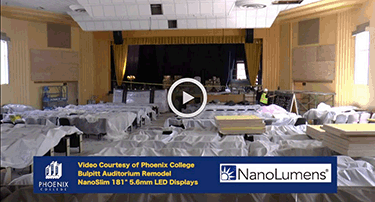In the depths of the Great Depression President Franklin D. Roosevelt promised the American people a “New Deal.” From 1933 through 1943, a constellation of federally sponsored programs put millions of jobless Americans back to work and helped to revive a moribund economy. These programs produced a rich landscape of public works across the nation, often of outstanding beauty, utility, and craftsmanship.
One of these establishments was Phoenix College, the flagship institution of the Maricopa County Community College District and one of the largest community college districts in the nation. Now, with the help of NanoLumens, a leading manufacturer and marketer of indoor LED displays, Phoenix College is educating the AV/IT industry on how to integrate 21st century technology into a 20th century architectural masterpiece.
“In 1939 Phoenix College retained the architectural firm of Lescher and Mahoney with Public Works Administration funds to design the first six buildings for the new campus,” explained Mike Poplin, director of technology support and media services, Information Technology department. “The Arts and Science buildings; gymnasium; combination library, Bulpitt Auditorium and administration building; cafeteria; and a central heating plant formed the core of the college for many years.”
The Bulpitt Auditorium serves as the centerpiece for Phoenix College and hosts many important college, district and community events, explained Dr. Mark Koan, CIO and Dean of Information Technology. “As we considered the range of diverse events hosted in this venue, as well as the college’s commitment to innovation, we focused our design goals on enhancing the auditorium’s historic appeal with state-of-the-art lighting, audio, and video technology. When we found the video solution from NanoLumens, we knew we had to find a way to work it into the budget. We couldn’t be more pleased with the results.”
According to Doug McCarthy, director, Phoenix College facilities planning & development, great care was exercised in the planning and execution of the auditorium’s renovation to preserve the integrity of the Art-Deco/Early Mid-Century design while bringing it up to current code compliance and functionality. “Chip Shay of SPS+ Architects was retained to design the project. Chip is a certified acoustician who also has a great deal of experience in theater renovation. The success of this project was a result of a strong collaboration with the college’s Facilities Planning, Administration, Music, and IT departments. The vision and goal was to create an environment conducive to compete with and/or exceed modern Phoenix venues, while honoring the past glory of the historic building.”
The renovation involved the installation of new electric rigging and drapes, LED lighting, mechanical systems, structural enhancements and cosmetic renovations. Great care was taken in the selection of the finishes, windows, lighting devices and colors to enhance and capitalize on the original design of the building. Even the original outside lighting fixtures were refurbished and reused. These fixtures are now re-installed with LED lamps; an example of the level of detail that went into the project. Each need examined in the planning and completion of this project was reviewed for relevance from a functional and historic standpoint.
Phoenix College chose NanoLumens to supply two 5mm NanoSlim displays, each measuring 181” diagonally, based on several important characteristics, according to Poplin. “No other company comes close to offering the same combination of technology, customization, and warranty. Our new installation is expected to have a lifespan of 100,000 hours or 11 years, which ever comes first, and NanoLumens is guaranteeing this performance with its unprecedented six-year, zero defect warranty program.”
Add to this the fact that the NanoLumens displays are ultra-thin and light in weight, manufactured in the United States, feature ‘hot-swappable’ LED nixels, are front serviceable, deliver a seamless bezel-free viewing experience and are designed to be extremely quiet and energy efficient — “and the selection of NanoLumens became the right one for us,” Poplin emphasized. “What’s more, the new installation space features completely open windows that had been covered up by dry wall for many years. Even with the new open windows, the NanoLumens displays deliver an outstanding picture quality!”










